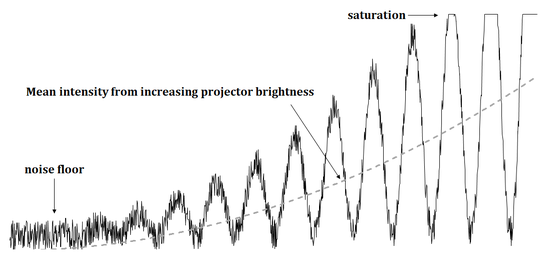Projector Brightness¶
Introduction¶
Projector brightness controls the output power and thus the amount of light that is emitted by the projector. Using the projector brightness is the most efficient way to maximize signal-to-noise ratio (SNR). Maximizing projector brightness will maximize the amplitude of the signal received by the camera. This minimizes impact from noise, as long as the reflected light from the projector does not over-saturate the pixel. At the same time as improving the peak signal amplitude, increased brightness also affects the mean intensity of the image. This also means that projector brightness can be used to control exposure, measured in stops.

Zivid Projector¶
The projector brightness variable in Zivid is based on a relative value where 1.0 is default and 0.0 is projector off. The table below shows how the available projector brightness in Zivid One+ relates to stops.
Brightness |
0.25 |
0.50 |
1.00 |
1.80 |
|
Stops |
-2 |
-1 |
0 |
+0.85 |
|
Lumen |
Zivid One+ |
100 |
200 |
400 |
720 |
Zivid Two |
90 |
180 |
360 |
650 |
|
Note
Zivid Two has a smaller projector area and a higher light density (w/m2) than Zivid One+ cameras.
For example, by increasing the projector brightness from 0.50 to 1.00, the average intensity of the image will increase by 1 stop.
It is recommended to keep the concept of SNR in mind when selecting projector brightness, and therefore keep it high when possible. This is especially true in the presence of strong ambient light or imaging at distances above 1m.
Note
The Zivid 3D cameras are fitted with a thermal safety mechanism that prevents the camera from overheating.
If projector brightness greater than 1.0 is used, a thermal safety mechanism will limit the maximum duty cycle of the camera. This is to ensure that the internal temperature can stabilize. The way that one will experience this thermal throttling is that the camera will pause during capture. This lets the camera cool off for a short amount of time, about 1 second, before it can continue to capture. This halting will occur approximately once every 10 seconds. Thermal throttling will typically kick in if the camera acquisition is running at a duty cycle of 70% or more with projector brightness above 1.0.